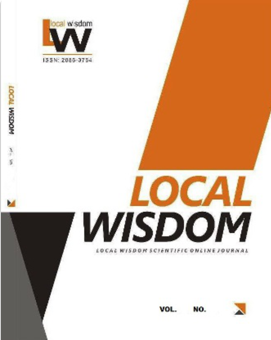Typology and Morphology of Traditional Sasak Settlement
DOI:
https://doi.org/10.26905/lw.v16i1.10264Keywords:
typology, morphology, traditional settlements, sasak tribe, traditional architectureAbstract
The cultural richness that characterizes Sasak is reflected in the form of architecture, landscape patterns, and settlements. It is known that there are six traditional villages, each of which has a share in the enrichment of Sasak culture and beauty. The architectural objects taken are from traditional villages on Lombok Island inhabited by the Sasak Tribe by exploring the historical and socio-cultural significance to explain their unique characteristics and the influence of history and cultural beliefs on settlement patterns. This research focuses on physically grouping settlement patterns and relating them to culture and local regulations to find the typology and morphology of traditional Sasak settlements. These two classifications are influenced by history and the phenomenon of the 2018 earthquake in these settlements, highlighting the resilience and cultural significance of traditional Sasak structures. Key findings include the classification of two forms of Sasak architecture settlement patterns: hilly Sasak architecture and flat land Sasak architecture., each with distinct characteristics and orientations. The study provides valuable insights into the architectural, historical, and cultural aspects of traditional Sasak settlements, contributing to a deeper understanding of their significance and unique characteristics.Downloads
References
Achmad, Z. H. (2019). Typology of Bena traditional architecture, Flores. Local Wisdom: Jurnal Ilmiah Kajian Kearifan Lokal, 11(2), 90–106.
Afdholy, A. R. (2017). Tipomorfologi Permukiman Tepian Sungai Martapura Kota Banjarmasin. Local Wisdom, 9(1), 33–50.
Al-Mohannadi, A. (2019). The Spatial Culture of Traditional and Contemporary Housing in Qatar. A Comparative Analysis based on Space Syntax. quspace.qu.edu.qa.
Amiuza, C. (2006). Tipologi Rumah Tinggal Administratur PG Kebon Agung di Kabupaten Malang. Jurnal Ruas. IV (1), 1–22.
Arida, I. N. S., & Pujani, L. K. (2017). Study of Preparation of Tourism Village Criteria as a Basic Instrument for Tourism Village Development. Jurnal Analisis Pariwisata, 17(1), 1–9.
Arief, A. Z., & Subadyo, A. T. (2017). Sustainability in Architecture of traditional Sasak settlements in Lombok. International Conferences SDGs 2030 Challenges and Solutions, 1(1).
Burhan, I. M. (2008). Pola Tata Ruang Permukiman Tradisional Gampong Lubuk Sukon, Kabupaten Aceh Besar. Universitas Brawijaya.
Feng, Q. (2014). A Typo-morphological Enquiry into the Evolution of Urban and Architectural Forms in the Huangpu District of Shanghai, China. 1–189.
Habraken, N. J. (1978). The systematic design of support. Cambridge, Massachusetts: Math Lab of Arch and Planning at MIT.
Hao, Z. (2018). Study on the Spatial Morphology and Protection Strategy of Tusi Official Village of Qinghai-Tibet Plateau—Taking Zhuo Keji Official Village as an Example. In DEStech Transactions on Engineering and Technology Research. DEStech Publications. https://doi.org/10.12783/dtetr/iccere2017/18287
Ischak, M., Setioko, B., & Nurgandarum, D. (2018). Spatial Typo-morphology of Residential House in Supporting to the Resilience of the Indigenous Settlement in the Sub-urban Area, Case: Enclave Settlement in the New Town of Gading Serpong. International Journal of Rural Development, Environment and Health Research, 2(3), 46–55. https://doi.org/10.22161/ijreh.2.3.6
Jayadinata, J. T. (1992). Tata Guna Tanah Dalam Perencanaan Pedesaan Perkotaan dan Wilayah. ITB.
Kasatkin, S. (2021). Typology of legal theories: positivist tradition and challenges of interpretativism. In Gosudarstvo i pravo (Issue 4, p. 70). The Russian Academy of Sciences. https://doi.org/10.31857/s102694520013149-4
Kemendikbud. (2022). No Title. www.Kemendikbud.co.id
Loekito, J. (1994). Studi Tentang Tipologi Tampak Rumah Tinggal di Kampung Surabaya pada Periode Sebelum Tahun 1942. Laporan Penelitian. Tidak Dipublikasikan.
Mannan, K. A. (2019). The Typology Of Traditional House: Bale Tani In Sade Village, Lombok, West Nusa Tenggara. In International Journal on Livable Space (Vol. 2, Issue 2, p. 21). Universitas Trisakti. https://doi.org/10.25105/livas.v2i2.2265
Mansilla, J. A., & Milano, C. (2019). Becoming centre: Tourism placemaking and space production in two neighborhoods in Barcelona. Tourism Geographies.
Moneo, R. (1976). Aldo Rossi: The Idea of Architecture and the Modena Cemetery (5th ed.). Oppositions.
Pramitasari, P. H., & Harjanto, S. T. (2022). The Role of Local Wisdom Values for Achieving Healthy Housing Concept in Humid Tropical Climate. Local Wisdom: Jurnal Ilmiah Kajian Kearifan Lokal, 14(1), 73–83.
putra, seno himala. (2019). Morphology of Talang Mamak Tribe Dialect At Indragiri Regency of Riau Province, Indonesia. Center for Open Science. https://doi.org/10.31227/osf.io/krc45
Putri, M. A., Rahayu, M. J., & Putri, R. A. (2017). Bentuk Morfologi Kawasan Permukiman Urban Fringe Selatan Kota Surakarta. Jurnal Pengembangan Kota, 4(2), 120–128.
Rahim, M., Basri, A., & Fauzi, H. (2018). Typology of Bajo Tribe Settlement in North Maluku. In IOP Conference Series: Earth and Environmental Science (Vol. 213, p. 12028). IOP Publishing. https://doi.org/10.1088/1755-1315/213/1/012028
Ramaiah, M., Avtar, R., & Rahman, M. (2020). Land Cover Influences on LST in Two Proposed Smart Cities of India: Comparative Analysis Using Spectral Indices. Land.
Rapoport, A. (1969). House form and culture. Engelwood Cliffs. NJ: Prentice-Hall.
Ronald, A. (2008). Kekayaan dan Kelenturan Arsitektur. Muhammadiyah University Press.
Sabrina, R., Antariksa, A., Prayitno, G., Sabrina, R., Antariksa, A., & Prayitno, G. (2010). Pelestarian Pola Permukiman Tradisional Suku Sasak Dusun Limbungan Kabupaten Lombok Timur. Jurnal Tata Kota Dan Daerah, 1(2), 87–108.
Sofield, T., Guia, J., & Specht, J. (2017). Organic 'folkloric'community driven place-making and tourism. Tourism Management, 61, 1–22.
Subadyo, A. T. (2003). Arsitektur Tradisional Lombok. Jurusan Arsitektur Universitas Merdeka Malang.
Sugiyono. (2016). Metode Penelitian Kuantitatif, Kualitatif dan R&D. PT Alfabet. Danandjadja, James Folklor Indonesia.
Susilo, G. A., & Umniati, B. S. (2021). Model Tata Massa Arsitektur Sasak di Pulau Lombok. Jurnal Lingkungan Binaan Indonesia, 10(1), 48–57.
Susilo, G. A., Umniati, S., & Pramitasari, P. H. (2019). Tipe dan Tata Masa Arsitektur Sasak di Pulau Lombok. Surya Pena Gemilang.
Trancik, R. (1991). Finding lost space: theories of urban design. John Wiley & Sons.
Umar, M. Y. H., & Sukandi, A. I. (1987). Selintas rumah tradisional Sasak di Lombok. Departemen Penidikan dan Kebudayaan, Direktorat Jenderal Kebudayaan, Museum Negeri Nusa Tenggara Barat.
Wahyudi, D. S., Wikantiyoso, R., & Tani, B. (2021). Limbungan Local Wisdom and Conservation of Vernacular Architecture East Lombok Sasak. Local Wisdom: Jurnal Ilmiah Kajian Kearifan Lokal, 13(2), 165–176.
Widisono, A. (2019). The Local Wisdom on Sasak Tribe Sade Hamlet. In Local Wisdom : Jurnal Ilmiah Kajian Kearifan Lokal (Vol. 11, Issue 1, pp. 16–41). Universitas Merdeka Malang.
https://doi.org/10.26905/lw.v11i1.2711
Wiriaatmadja, S. (1972). Pokok-pokok sosiologi pedesaan. In (No Title).












